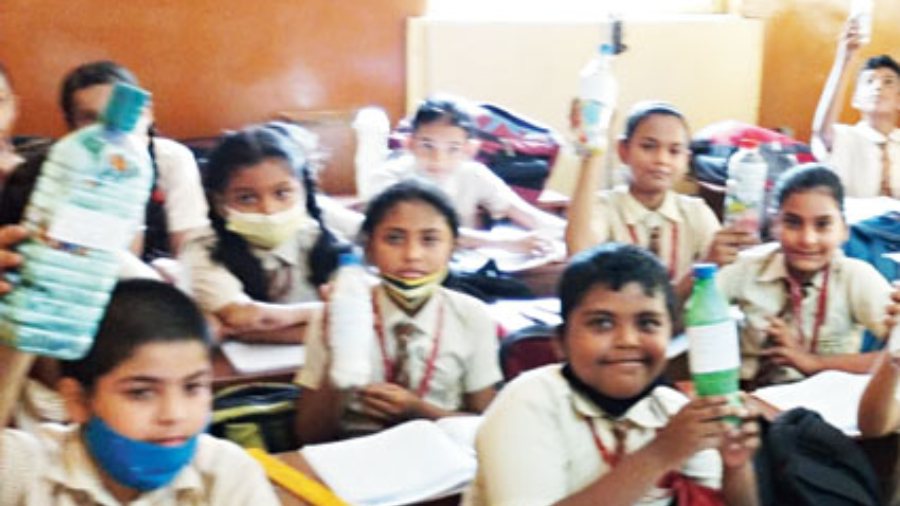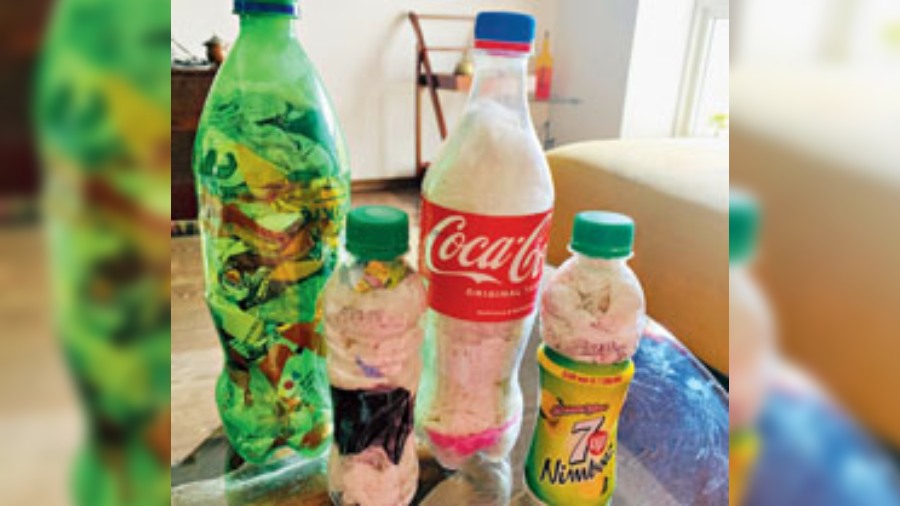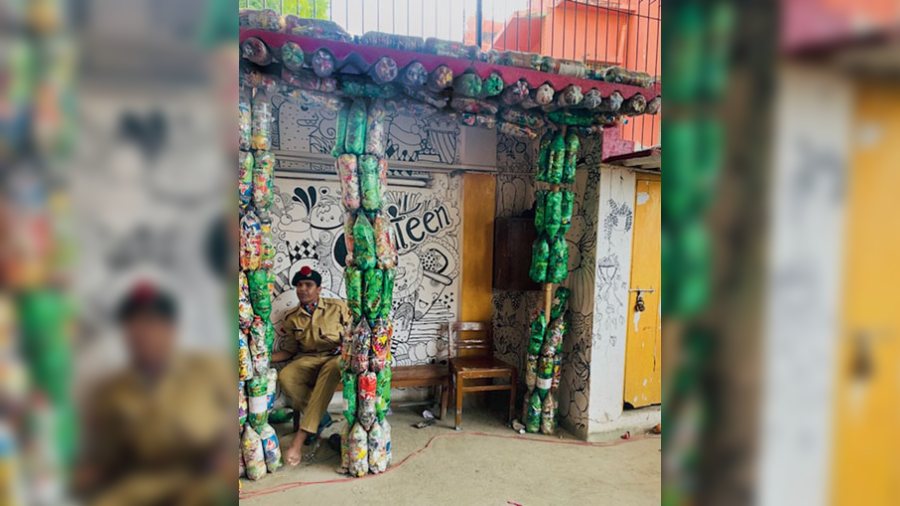As 99 per cent of plastics are made from fossil feedstock, plastic pollution is linked with climate change. Where do we stand as a human race with respect to global plastic pollution and how can we as individuals and households reduce our consumption and lead plastic-conscious lifestyles? Implementing integrated solutions to address two of the most critical global problems of this century, namely, plastic pollution and climate change, would help us achieve net-zero goals while protecting communities and habitats.
The Global scenario
The world is producing twice as much plastic waste now as it was two decades ago, with the bulk of it ending up in landfills that are being incinerated or leaking into the environment. Only 9 per cent of the waste is successfully recycled, according to a new OECD report.
Bans and taxes on single-use plastics exist in more than 120 countries, but are not doing enough to reduce overall pollution. Most regulations are limited to daily use items like plastic bags, which make up a tiny share of plastic waste and are more effective at reducing littering than curbing plastic consumption.
Landfill and incineration taxes that incentivise recycling only exist in a handful of countries. Global plastics production doubled from 2000 to 2019 to reach 460 million tonnes.This is because plastic is the cheapest and most durable form of packaging and easiest to transport
As mentioned above, of the total plastic waste generated, only 9 per cent is recycled — 15 per cent is collected for recycling but 40 per cent of that is disposed of as residues. Another 19 per cent is incinerated, 50 per cent ends up in landfills and 22 per cent evades waste management systems and goes into uncontrolled dumpsites or is burned in open pits, especially in poorer countries like India.
In 2019, 6.1 million tonnes (Mt) of plastic waste leaked into aquatic environments and 1.7 Mt flowed into oceans. Humans are exposed to a large variety of toxic chemicals and microplastics through inhalation, ingestion, and direct skin contact, all along the plastic life cycle. According to WWF, an average person could be ingesting approximately 5g of plastic every week.
While the health impacts of plastics is still a rather new research area, scientific results do indicate that the toxic chemical additives and pollutants found in plastics threaten human health on a global scale. Scientifically-proven health effects include causing cancer or changing hormone activity (known as endocrine disruption), which can lead to reproductive, growth, and cognitive impairment.
Experts feel that the only way to tackle this is by reducing production. Plastic pollution is one of the global hazards which points directly to that the triple crises that we are facing — pollution, biodiversity loss and climate change. So, a shift in approach and lifestyle is needed to reflect the fast growing global trend of looking at waste as a resource.
Recycling, composting and waste-to-energy are increasingly being adopted as alternative waste management strategies. Advantages include reduced pollution and improved environmental performance, beneficial health and social impacts, and enhanced employment and economic opportunities.
The Indian Scenario
India generates around 5.6 million tonnes of plastic waste annually with Delhi being the highest generator of plastic waste in India accounting for 9,600 tonnes per day among the top 10 cities, followed by Chennai, Kolkata, Mumbai, Bangalore and others. Countries like India face the additional challenge of legacy waste, i.e., waste that has been left unattended and untreated in dumps for years. Moreover, the prolonged pandemic and the explosion of retail spaces such as FMCG markets, e-commerce, and food delivery services have only increased plastic consumption.

School students show ecobricks they made
Recycling – the need of the hour and The Positive news
In 2021, Union environment minister Prakash Javadekar tweeted, “Plastic per se is not a problem; it is uncollected plastic waste that is.” According to a Central Pollution Control Board report of 2019-20, India recycles around 60 per cent of plastic waste. The remaining 40 per cent ends up in landfills, on the streets, clogging water bodies, etc. Unmanaged plastic also makes its way into the bellies of grazing animals, making it a concerning nuisance. This undisposed plastic is leading to a major plastic crisis.
To curb the country’s plastic pollution, the Central Government also announced a ban on single-use plastic across the country. Single-use plastics include items such as grocery bags, bottles, food cutlery and straws. However, just the ban isn’t sufficient to tackle plastic waste. There must be guidelines issued for alternatives to plastics, which at the moment are missing from the government rules.
Many start-ups are focusing on building businesses in the waste management space. Their main goal is to recycle non-degradable waste into valuable resources. This is a good start, considering such innovative ideas can save the environment from catastrophic climate change consequences. For instance, a Pune-based start-up is developing sustainable materials to replace plastic.
This start-up is developing paper cups that can hold hot liquids but can get decomposed in the natural environment within six months. Another start-up is making shoes from waste, sourced from a waste removal company that hires rag pickers. A lot of clothing brands are opting for sustainable fashion as opposed to fast fashion, which has a negative environmental impact.
At an individual , community level how we can address this issue is most pertinent.
In September 2021, the India Plastics Pact (IPP) was signed under a collaboration between the WWF and the Confederation of Indian Industry with support from UK Research and Innovation. The IPP, the first of its kind in Asia, aims at a circular economy for plastics with innovative ways to eliminate, reuse, or recycle the plastic packaging across the plastics value chain and forge collaborations between businesses and NGOs to collectively achieve long-term targets. International brands like Amazon and Coca-Cola, and Indian companies like Hindustan Unilever, ITC, Tata Consumer Products and three of Godrej’s trademarks have signed the pact.
In most cities plastic waste is found in one of the following forms: MLP (multi-layer packaging), PET (polyethylene terephthalate) plastics, LDPE (low-density polyethylene), HDPE (high-density polyethylene), Tetra Pak and synthetic fibres. Any other waste found on site such as medical waste is included in the ‘Others’ category.
While we must know the deadly enemy which has crawled into and settled in our lives, it is also necessary as citizens to replace any single-use items with reusable ones — like reusable water bottles and mugs — and reuse packaging material (pallets, drums, bubble wrap or packing peanuts, as well as shipping containers like boxes, inserts and cartons). We can also reuse printer cartridges by having them refilled.
At an individual and community level how do we need to find alternatives to refuse.We can replace our plastic bags with cloth bags. At Mrittika Earthy Talks (MET) we promote the use of the upcycled cloth bags for daily use, jute bags and packaging material or natural biodegradable materials like saal leaves and banana leaves. Mind you, paper, though biodegradable, has a big carbon footprint because of the water used and the processing cost. You can replace your plastic toothbrushes with recycled wooden ones.
Globally, ecobricks are being made by reusing plastic. Plastic bottles of aerated drinks, mineral water, oil, etc., are cleaned and dried. Each bottle is stuffed with strips of SUP (single-use plastic shopping bags) and MLPs cut into strips. With the back of a ladle or paintbrush these plastic strips which are not biodegradable are shoved in tightly to make strong brick like bottles. Anticipating the plastic pollution during the festive season, our Mrittikamate Yogini Bapat, who is a certified ecobrick maker, took a workshop at Bunaphile cafe.
What’s an ecobrick?
An ecobrick is made by using the Earth’s principle of carbon sequestration. An ecobrick is a PET bottle compacted with used non recyclable soft polythenes.

Somini Sen Dua (left) at an ecobrick making workshop with Yogini Bapat a certified ecobrick maker

How to make
- Clean and dry pet bottle
- Clean and dry non-recyclable polythenes
- A stick (Magic Wand)...not kidding
Fill the pet bottles with the dry polythenes and compact it using a stick.
Advantages
- Durability
- Water resistance
- Inspiration for everyone to reduce their plastic waste
- Protects animals and aquatic life
- Reduces global warming
- Prevents breaking down into micro plastics
- Low-energy solution to plastic waste as it doesn’t demand technology or funds. It can be made anywhere by anyone with the basic abilities and some waste in hand.
Testing
- Squeeze test: It should be hard enough and not make a crackling sound.
- Weight test: Weight of the ecobrick = 0.33 x volume of the brick
Weight chart according to Global Ecobrick Alliance
- Standard minimum density of ecobrick =0.33g/ml
- Standard maximum density of ecobrick =0.7g/ml
- An ecobrick’s minimum weight in grams = vol of bottle x 0.33
E.g. For 1000ml minimum weight = 330g and maximum weight = 700g.
Uses
- Ideal for constructing simple garden spaces or playgrounds.
- Can be used in making furniture.
- Can be used to construct pavements and roads, also low-cost buildings and housing. (It’s always better to have a covered space for any ecobrick construction. Broken modules can be mended with silicone.)
- Can be reused in construction by covering them completely with the concrete or mud mixture (cradle to cradle).
We shall be sending our first lot of 300 ecobricks to the Sunderbans for low-cost housing. This is just the beginning. Our members have made a few but most have come from schools and the elderly from a yoga and wellness centre in Bhawanipore.
We would like to appeal to schools and colleges to come forward and as a community combat the plastic peril. (Contact us for demo workshops.)
The author is a public relations professional and social entrepreneur.
